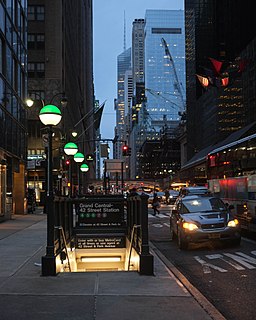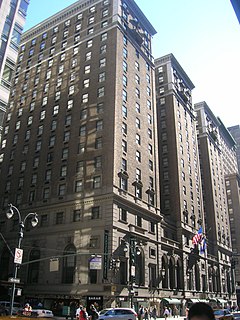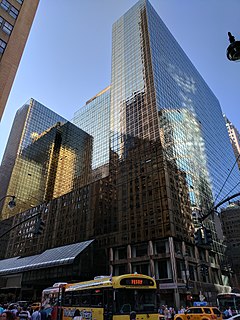
Grand Central Terminal is a commuter rail terminal located at 42nd Street and Park Avenue in Midtown Manhattan, New York City. Grand Central is the southern terminus of the Metro-North Railroad's Harlem, Hudson and New Haven Lines, serving the northern parts of the New York metropolitan area. It also contains a connection to the New York City Subway at Grand Central–42nd Street station. The terminal is the third-busiest train station in North America, after New York Penn Station and Toronto Union Station.

Hyatt Hotels Corporation, commonly known as Hyatt Hotels & Resorts, is an American multinational hospitality company headquartered in the Riverside Plaza area of Chicago that manages and franchises luxury and business hotels, resorts, and vacation properties.

The MetLife Building is a skyscraper at Park Avenue and 45th Street, north of Grand Central Terminal, in the Midtown Manhattan neighborhood of New York City. Designed in the International style by Richard Roth, Walter Gropius, and Pietro Belluschi, the MetLife Building is 808 feet (246 m) tall with 59 stories. It was advertised as the world's largest commercial office space by square footage at its opening, with 2.4 million square feet (220,000 m2) of usable office space. As of 2021, the MetLife Building remains one of the 100 tallest buildings in the United States.
Bowman-Biltmore Hotels was a hotel chain created by the hotel magnate John McEntee Bowman.

Grand Central–42nd Street is a major station complex of the New York City Subway. Located in Midtown Manhattan at 42nd Street between Madison and Lexington Avenues, it serves trains on the IRT Lexington Avenue Line, the IRT Flushing Line and the 42nd Street Shuttle. The complex is served by the 4, 6, and 7 trains at all times; the 5 and 42nd Street Shuttle (S) trains at all times except late nights; the <6> train during weekdays in the peak direction; and the <7> train during rush hours and early evenings in the peak direction.

The Miami Biltmore Hotel is a luxury hotel in Coral Gables, Florida, United States. It was designed by Schultze and Weaver and was built in 1926 by John McEntee Bowman and George Merrick as part of the Biltmore hotel chain. The tower is inspired by the Giralda, the medieval tower of the cathedral of Seville. When completed it became the tallest building in Florida at 315 feet (96 m) holding the record until 1928 when the Dade County Courthouse was built. At one time, the pool was the largest pool in the world and employed swimming instructor Johnny Weissmuller. It served as a hospital during World War II and as a VA Hospital and campus of the University of Miami medical school until 1968. Abandoned for many years it became a hotel again in 1987.

The New York Biltmore Hotel was a luxury hotel in New York City that opened in 1913. It was one of three palatial hotels built as part of the Terminal City development around Grand Central Terminal in Midtown Manhattan. The others were the Commodore Hotel, and the Roosevelt Hotel. The building was gutted by developers in 1981, with predominantly its steel frame remaining. The current building has been known as Bank of America Plaza, and more recently as 335 Madison Avenue.

One Grand Central Place, originally the Lincoln Building, is a 53-story, 673 feet (205 m) tall neo-Gothic office building at 60 East 42nd Street in Midtown Manhattan, New York City. It is bounded by Madison Avenue to the west, East 41st Street to the south, and Park Avenue to the east. One Grand Central Place is adjacent to other skyscrapers such as the Chrysler Building, MetLife Building, and One Vanderbilt, and it also has a direct in-building access to Grand Central Terminal to the north. As of 2021, it is the 91st-tallest building in the city, tied with the 277 Fifth Avenue, Barclay Tower, and One Court Square.

The Trump Organization is a group of about 500 business entities of which Donald Trump is the sole or principal owner. Around 250 of these entities use the Trump name. The organization was founded in 1927 by Donald Trump's paternal grandmother, Elizabeth Christ Trump, and his father, Fred Trump, as E. Trump & Son. Donald Trump began leading it in 1971, renamed it around 1973, and handed off its leadership to his children in 2017.

Warren and Wetmore was an architecture firm in New York City which was a partnership between Whitney Warren (1864–1943) and Charles Delevan Wetmore, that had one of the most extensive practices of its time and was known for the designing of large hotels.
Schultze & Weaver was an architecture firm established in New York City in 1921. The partners were Leonard Schultze and S. Fullerton Weaver.

The Roosevelt Hotel was a historic hotel located at 45 East 45th Street in Midtown Manhattan, Manhattan, New York City. Named in honor of President Theodore Roosevelt, the Roosevelt opened on September 22, 1924. It closed permanently on December 18, 2020.

Argent Ventures, LLC. is a privately held real estate company based in New York City that most notably owned the land under Grand Central Terminal and the land around 156 miles (251 km) of Metro-North Railroad railway tracks in the New York City metropolitan area from 1994 to 2018.

270 Park Avenue has been the name or address of several structures on the west side of Park Avenue, between 47th Street and 48th Street, in the Midtown Manhattan neighborhood of New York City.

The Atlanta Biltmore Hotel and Biltmore Apartments is a historic building located in Atlanta, Georgia. The complex, originally consisting of a hotel and apartments, was developed by William Candler, son of Coca-Cola executive Asa Candler, with Holland Ball Judkins and John McEntee Bowman. The original hotel building was converted to an office building in 1999. The building is currently owned by the Georgia Institute of Technology and is adjacent to Technology Square.

The New York Hilton Midtown is the largest hotel in New York City and world's 101st tallest hotel. The hotel is owned by Park Hotels & Resorts and managed by Hilton Worldwide. At 1,929 rooms and over 150,000 sq ft of meeting space, the hotel is the largest Hilton in the continental U.S.

The Graybar Building, also known as 420 Lexington Avenue, is a 30-story office building in Midtown Manhattan, New York City. Designed by Sloan & Robertson in the Art Deco style, the Graybar Building is at 420–430 Lexington Avenue between 43rd and 44th Streets, adjacent to Grand Central Terminal.

Grand Central Terminal is a major commuter rail terminal in Midtown Manhattan, New York City, serving the Metro-North Railroad's Harlem, Hudson and New Haven Lines. It is the most recent of three functionally similar buildings on the same site. The current structure was built by and named for the New York Central & Hudson River Railroad, though it also served the New York, New Haven and Hartford Railroad. Passenger service has continued under the successors of the New York Central and New Haven railroads.

Terminal City, also known as the Grand Central Zone, is an early 20th century commercial and office development in Midtown Manhattan, New York City. The space was developed atop the former Grand Central Station railyard, after the New York Central Railroad decided to rebuild the station into Grand Central Terminal, and reshape the railyard into a below-ground train shed, allowing roads and skyscrapers to be built atop it.





















